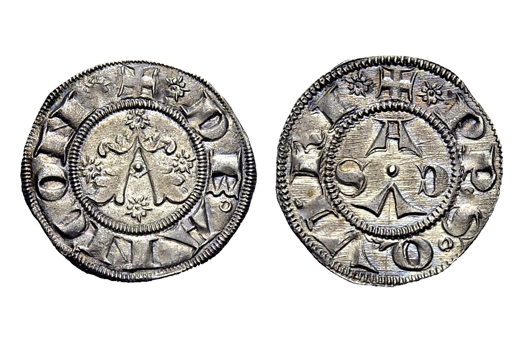
about ancient nomos
Ancient Nomos Art is a museum of galleries exhibiting ancient coins and ancient mint maps. The coin gallery displays the diverse art and history of hand-crafted ancient Greek, Roman, Byzantine, Persian and Medieval coinage. The ancient mints mapping gallery features Greek, Roman, Byzantine, Asia Minor and Medieval mint city regions and territories. Visitor's are welcome to explore, study and enjoy Ancient Nomos Art.

Medieval, Ancona – 1300 AD
Ancona Agontano
From Ancient Galleries

Obverse: Large ornate Gothic A in center with central pellet, surrounded by four 10 petal rosette flowers.
Reverse: Legend: PP °S °QVIRI, continued with central letters A C V S in cross pattern around inner pellet.
LEGEND
Obv: * + * (cross in rosette stops), DE °ANCON (one annulet stop), large ornate Gothic (Lombardic style) ![]() in center with central pellet, surrounded by four 10 petal rosette flowers in cross pattern; inner and outer protective border of denticles. Rev: * + * (cross in rosette stops), PP °S °QVIRI (two annulet stops), central letters A C V S in coat-of-arms cross pattern around a central pellet; inner and outer protective border of denticles.
in center with central pellet, surrounded by four 10 petal rosette flowers in cross pattern; inner and outer protective border of denticles. Rev: * + * (cross in rosette stops), PP °S °QVIRI (two annulet stops), central letters A C V S in coat-of-arms cross pattern around a central pellet; inner and outer protective border of denticles.
The medieval city of Ancona is located along the Adriatic coast of Italy and upland to the ridge line edge of the Apennines Mountains. The earliest settlers to the Ancona coast are thought to have been Dorian Greeks seeking refuge from the tyrant Dionysius of Syracuse, circa 390 BC. The Greek Dorian settlers named the coastal enclave “Anchon” meaning the elbow, given to the natural semicircular shape of the mountain rocks that form its natural Adriatic harbor. Since its founding, Ancona has been a prosperous trade based community fostering an extensive exchange of textiles and a variety of agricultural produce. Additionally, when Ancona began issuing its medieval silver based coinage, the city rapidly develop into a sophisticated economy based on finance and banking which extended throughout the European continent. During the sixth century, Ancona and its greater Marche region became a part of the Maritime Pentapolis of five cities under the authority of the Byzantine Empire and subject to the Lordship exarchate of Ravenna, representing the Byzantine Emperor. During the ninth century, Emperor Otto III granted the entire Pentapolis of five cities to the Papacy in Rome, but Ancona rejected the exchange and control by the church subsequently failed. After multiple sieges during the early middle-ages, Ancona finally established a semi-autonomous republic or commune in the early twelfth century and lasting well into the sixteenth century. The magnificent medieval Ancona coin above was issued during the mid-twelfth century, at the height of the cities prosperity. By this time, Ancona had rebuilt and restructured its fortification walls protecting the city and the vital Adriatic trade merchants and growing citizen population at large. The Ancona silver coinage circulated widely in the region and abroad, serving as a model currency for other independent medieval communes in central Italy. The Ancona coinage was called anconetano or agontano, identified on the coin obverse by a large central letter A. Not only is this perhaps the finest known medieval Ancona coin, but the large central A is the most exquisitely detailed Lombardic capital font and rendered by a truly master artesian engraver in a high Gothic style (see also Lombardic M for Modena). The large central A serves to identify the city and coincidentally finishes the surrounding legend, DE ◦ ANCON, with the letter A for Ancona. The coin reverse identifies Judas Quiriacus, the patron saint of Ancona, in a surrounding legend, PP ◦ S ◦ QUIRI, finishing the saints name in the center with letters, ACUS, in the coat-of-arms shape of a cross pattern. The letter abbreviations PPS translate in Latin to mean, Perpetuus Patronus Sanctus, or in English, the Perpetual Patron Saint Quiriacus. The medieval fate of Ancona was always optimistic, even when the cities prosperity frustrated nearby Venice, which attacked Ancona in 1183, 1229, 1257, 1274-78 and in 1428 AD (Medieval Italy, Vol.1, 2004 by J.P. Lomax).
DOCUMENTATION
Value: Anconetano or Agontano. Metal: AR Silver. Weight: 1.00 grams. Mint: Republic of Ancona. Anonymous Issue. Date: circa late 13th into 14th Century AD.
Attribution: CNI Tavola I, 48; Biaggi 38; Dubbini; Mancinelli, Monete di Ancona.
Legend, Documentation and Attribution
